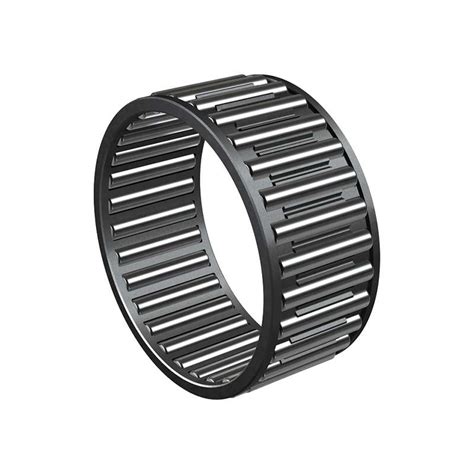Needle Roller Bearings: A Comprehensive Guide to Design, Application, and Maintenance
Introduction
Needle roller bearings are cylindrical rolling bearings with a long and slender shape, resembling needles. Their unique design enables them to accommodate high radial loads and operate at high speeds while maintaining a compact size. They are widely used in a variety of industrial and automotive applications, including transmissions, steering systems, and pumps.
Types of Needle Roller Bearings
Needle roller bearings are available in various types to meet specific application requirements:
Drawn Cup Needle Roller Bearings
These bearings consist of a thin-walled, drawn cup and a complement of needle rollers. They are suitable for high-speed applications and offer excellent radial load capacity.
Caged Needle Roller Bearings
These bearings feature needle rollers retained in a cage or separator, which prevents them from skewing or misaligning. They are commonly used in applications where high precision and rigidity are critical.

Full Complement Needle Roller Bearings
As their name suggests, these bearings contain the maximum possible number of needle rollers, providing the highest radial load capacity. However, they are not suitable for high-speed applications due to the lack of a cage.
Stud-Type Needle Roller Bearings
These bearings have a stud that extends from the outer ring, allowing them to be easily mounted and secured. They are often used in compact spaces or applications where a precision fit is required.

Applications of Needle Roller Bearings
Needle roller bearings are commonly found in the following applications:

- Transmissions and gearboxes
- Steering systems
- Pumps and compressors
- Machine tools
- Aerospace components
Benefits of Needle Roller Bearings
The primary advantages of needle roller bearings include:
-
High radial load capacity: The long and slender shape of needle rollers enables them to withstand significant radial loads.
-
Compact size: Needle roller bearings are compact in size, making them suitable for applications with limited space constraints.
-
High-speed capability: Drawn cup and caged needle roller bearings can operate at high speeds, making them ideal for high-performance applications.
-
Low friction: The line contact between the rollers and raceways reduces friction and wear, contributing to longer bearing life.
Design Considerations for Needle Roller Bearings
When selecting and designing needle roller bearings, several factors should be considered:
-
Load capacity: The bearing must be able to withstand the applied radial loads without failure.
-
Speed: The maximum operating speed should not exceed the bearing's specified limits.
-
Clearance: Proper clearance between the rollers and raceways is essential to prevent excessive friction and premature wear.
-
Lubrication: Needle roller bearings require adequate lubrication to minimize friction and extend their life.
Installation and Maintenance of Needle Roller Bearings
Proper installation and maintenance are crucial to the performance and longevity of needle roller bearings:
Installation:
- Ensure the bearing is correctly aligned and fitted into its housing.
- Use proper tools and techniques to avoid damaging the bearing.
- Apply a thin layer of lubricant to the bearing before installation.
Maintenance:
- Regularly inspect the bearing for signs of wear or damage.
- Clean and lubricate the bearing as recommended by the manufacturer.
- Avoid exposing the bearing to excessive heat or moisture.
Troubleshooting Needle Roller Bearing Issues
Common issues encountered with needle roller bearings and their troubleshooting steps include:
-
Noise or vibration: Check if the bearing is properly installed and aligned. Insufficient lubrication or excessive clearance can also cause noise.
-
Premature wear: Inspect the bearing for signs of contamination, corrosion, or overload. Ensure proper lubrication and clearance.
-
Seizure: This can occur due to excessive friction, contamination, or improper installation. Check for adequate lubrication and alignment.
Frequently Asked Questions (FAQs)
-
What is the main advantage of needle roller bearings?
- High radial load capacity in a compact size.
-
What applications are needle roller bearings best suited for?
- In transmissions, steering systems, pumps, and machine tools.
-
How often should needle roller bearings be lubricated?
- Refer to the manufacturer's recommendations, typically every few months.
-
What is the difference between drawn cup and caged needle roller bearings?
- Drawn cup bearings have a higher load capacity, while caged bearings offer better precision and rigidity.
-
How can I determine the appropriate size of needle roller bearing for my application?
- Consult with a bearing manufacturer or use online calculation tools based on the application requirements.
-
What causes noise in needle roller bearings?
- Inadequate lubrication, excessive clearance, or improper installation.
Tables
Table 1: Typical Applications of Needle Roller Bearings
| Application |
Industry |
| Transmissions |
Automotive, Industrial |
| Steering systems |
Automotive |
| Pumps |
Industrial, Automotive |
| Machine tools |
Manufacturing |
| Aerospace components |
Aerospace, Defense |
Table 2: Comparison of Needle Roller Bearing Types

| Type |
Features |
Advantages |
Limitations |
| Drawn Cup |
Thin-walled cup, high load capacity |
Compact, high speed |
Limited precision |
| Caged |
Needle rollers retained in a cage |
High precision, rigidity |
Reduced load capacity |
| Full Complement |
Maximum number of rollers, highest load capacity |
No cage, limited speed |
|
| Stud-Type |
Stud for easy mounting |
Precision fit, compact size |
Lower load capacity |
Table 3: Troubleshooting Needle Roller Bearing Issues
| Issue |
Possible Cause |
Troubleshooting Steps |
| Noise or vibration |
Improper alignment, insufficient lubrication, excessive clearance |
Check alignment, lubricate, reduce clearance |
| Premature wear |
Contamination, corrosion, overload |
Inspect for contamination, lubricate, reduce load |
| Seizure |
Excessive friction, contamination, improper installation |
Lubricate, inspect for contamination, ensure proper alignment |

